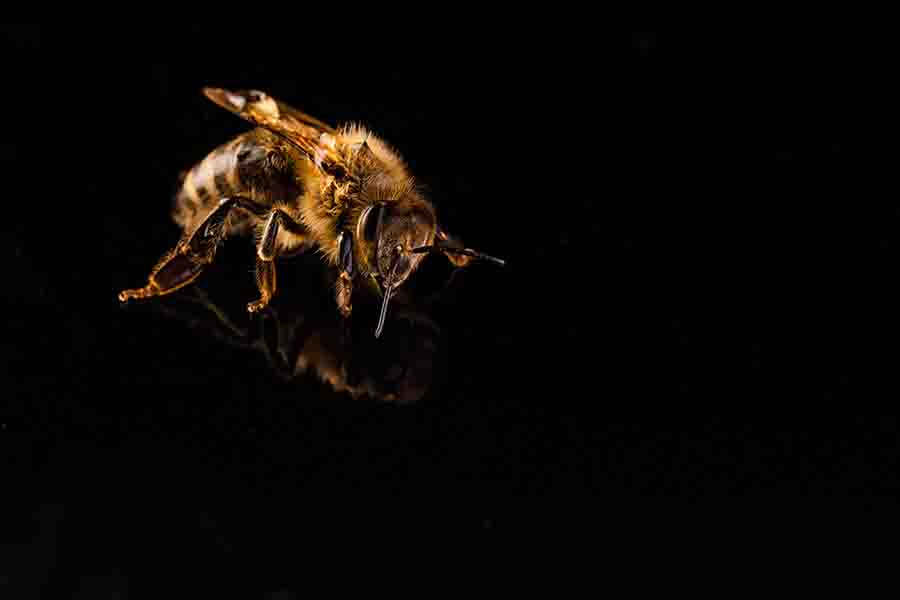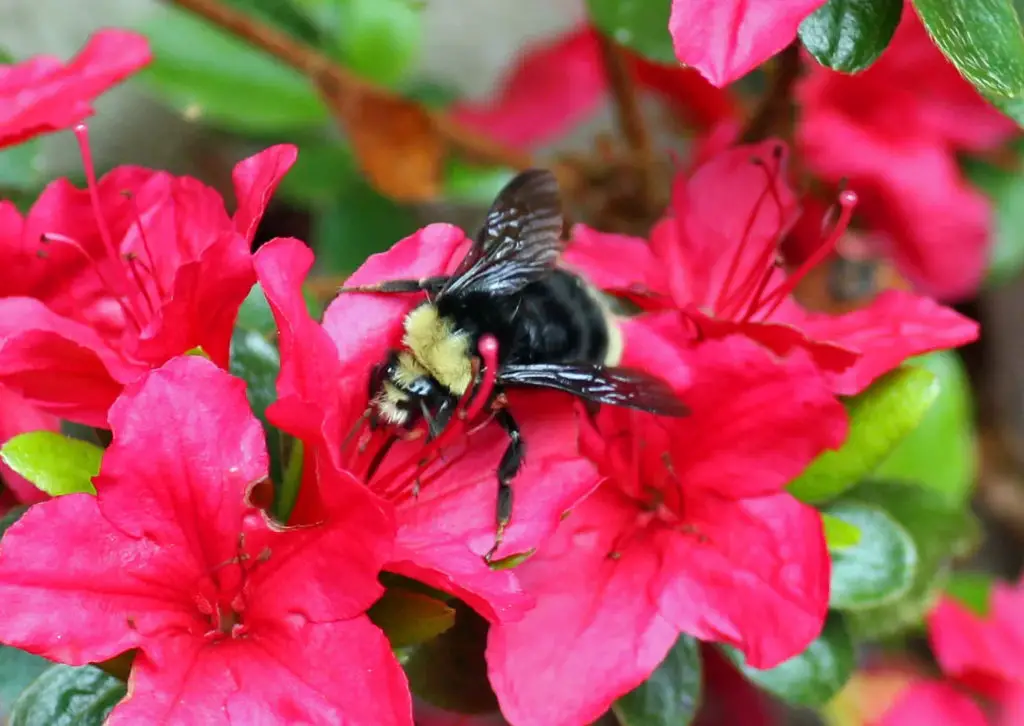Affiliate Disclaimer - As an Amazon Associate I earn from qualifying purchases.
It supports the website. So, Thank you
When summer comes around, you’ll see bees almost everywhere; collecting pollen and nectar and doing their bee duties. But when the sun goes down, it’s not very often you’ll see a bee buzzing around but why is that? Can bees fly in the dark?
Most bees are active in daylight hours but there are some species that are able to fly at night and have developed nocturnal habits.
It’s mainly tropical bee species that behave in this way. If you have a hive of honey bees or are thinking about most of the common species in the US then these are almost all diurnal (active during the day.) But let’s find out more about bees that fly in the dark.
Table of Contents
Do Bees Fly At Night?
Most of us would recognize bees as daytime insects and this is largely the case. Many, if not most, species of bees are active during the day. These are known as diurnal creatures and this simply means that they hunt and forage during the day.
That said, there are some rarer bee species that have adapted to flying in the dark and do most of their foraging at night; these are nocturnal bees.
For the most part, it’s only tropical species that are nocturnal and it seems that there is a good reason for this. In these areas, there are a lot of night-blooming plants such as jasmine and moonflower so it makes sense for the bees to collect their food at night especially since there are fewer competing species around.
There are a couple of notable nocturnal bee species which include the megalopta atra that comes from Panama. The Indian carpenter bee is another example of a bee that can fly in the dark. What’s special about this bee is that it can fly even in total darkness when there is no moonlight.
Crepuscular Bees
As well as nocturnal bees, there are some species that are crepuscular. This term refers to animals that perform most of their activity at dusk and dawn. There are a surprising number of crepuscular animals including rabbits, lions, and various species of owls.
Where bees are concerned, there are far more crepuscular species than there are nocturnal ones. However, these are still few compared to diurnal bees. Some examples of crepuscular bees include the caupolicana ocellata, the megalopta genalis, and the xenoglossa fulva.
Do Honey Bees Fly In The Dark?
One of the most common bee species in the world is the honey bee. Many of you reading this will be proud keepers of honey bee hives and they’re amazing creatures. But did you know that there are several subspecies of Honey Bee and some of these have the ability to fly at night, despite being diurnal?
These are the giant Asian honey bee and the African honey bee. Both of these bees do forage mainly during the day but if there is enough light from the moon then they are capable of flying at night. That said, this isn’t something they do regularly.
Why Do Some Bees Fly In The Dark?
It makes sense that most bee species are active during the day. This is a time when almost all of the plants are blooming and there is a good level of light so the bees can see what they’re doing. But when you think about it, there are some valid reasons that flying and foraging at night might be beneficial.
For starters, the bees aren’t going to be competing with a ton of other insects when they forage in the dark. All the other critters will be huddled away for the night so nocturnal bees have the pick of the crop. This is especially true where there are a lot of night-blooming flowers. There are some other animals foraging under the cover of darkness, like moths and bats, but the competition is considerably lower.
While some bees may be fearful of predators (and we’ll touch on that more in the next section), flying at night may be the time to avoid being eaten. When bees forage in the dark, they’re less likely to be seen so can gather nectar in relative peace. There are some nighttime predators to watch out for, but again, nowhere near as many as in the day.
Bees Dropping To The Ground In The Dark
Have you seen the viral video of bees dropping to the ground when the lights are turned off? This is a very strange phenomenon and something that has largely gone unexplained. However, there are a lot of people making the suggestion that the bees have developed a fear of nighttime predators, such as bats, and instinctively dive towards ground safety when it goes dark.
This is just a theory and has not been scientifically proven. But we think it’s pretty interesting how these bees are behaving and it certainly gives you food for thought. The real reason behind this behavior? You’ll have to make up your own mind.
Can Bees See In The Dark?
If a bee is going to forage at night then it makes sense that they should be able to see in the dark. Bees that are not adapted to fly at night don’t have great night vision. They may be able to make out images in the dark but they’ll be blurry and difficult to see.
They do this using their brains which extend the period of time that the photoreceptors are collecting light before any signals are sent. However, the problem with this is that the final image the bee sees won’t be very clear, especially if it’s a moving object.
Bees may also be able to see at night by collecting the photoreceptor signals and putting them together to make something that resembles a mosaic. Again, this wouldn’t be as clear as what the bee would see in the day and the details would all be missing.
But, nocturnal bees are quite a different story and have adapted large eyes which help them to see clearly even in low light.
How Do Bees’ Eyes Work?
Bees have two sets of eyes. In total, there are five eyes. The first set is called compound eyes and each bee has two of these. These eyes are what the bee uses to detect patterns and create images; they are the more complex of the two sets. Compound eyes come in handy when the bee needs to identify a plan and what’s amazing is that these eyes are able to see all around and in any direction.
Amazingly, the bee’s compound eyes have thousands of lenses each and each one of these picks up on the smallest part of an image. It’s only when they work altogether that the complete image can be seen.
While the compound eyes are quite big and cover a large portion of the bee’s face, there are also three less complex eyes known as ocelli. These are at the top of the head right in the centre. Unlike the complex compound eyes, the ocelli only have a single lens each. This is very much the same as a human eye.
These eyes are used to help the bee detect various types of light including ultraviolet, polarized, and infrared. The benefit of this is improved orientation.
All of this is relevant to daytime bees but those that are active at night have certain eye adaptations to help them better see in the dark. For starters, their eyes are much bigger, particularly the ocelli. In some cases, they may be double the size of that of a diurnal bee so the difference is quite significant.
But even with these adaptations, not all nocturnal bees are able to fly in complete darkness. In fact, quite a lot of night-flying bees require at least some light which often comes from the moon. Crepuscular bees may rely on the low light at dusk to help them navigate their way around.
Conclusion
Bees are usually most active during the day but this doesn’t apply to all species. If you’ve never seen a bee at night then you may have wondered can bees fly in the dark?
Diurnal bees don’t fly at night because their eyes are well developed enough to be able to see properly. They perform most of their activity during the day whereas some nocturnal species will only come out to forage under the cover of darkness.




